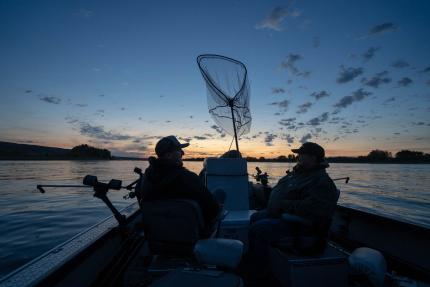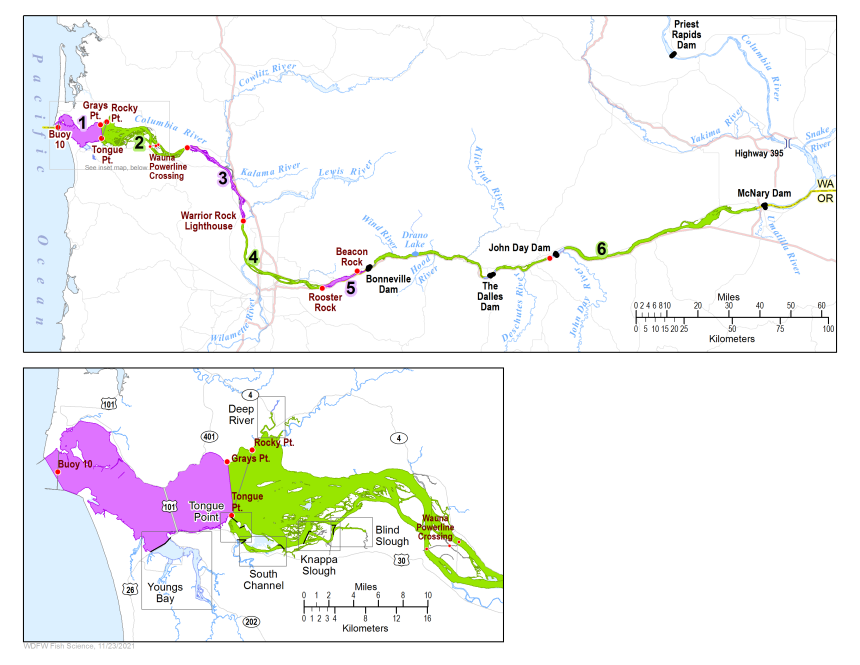
For up-to-date information on Columbia River and southwest Washington fishing, including weekly fishery updates, fishing tips, and more, refer to the Discover Southwest Washington fishing webpage.
Recreational fishing on the Columbia River is a bucket-list item for many anglers. Every year, dozens of distinct Chinook, coho, and sockeye salmon and steelhead runs return to the mouth of the Columbia River and head upstream, eventually finding their way into one of the many tributaries in Washington, Oregon, or even Idaho in hopes of completing their journey to spawn in their natal waters. In addition to these iconic fish, a multitude of other species -- such as shad, pikeminnow, smelt, and sturgeon-- also call the Columbia home and support additional fisheries.
But the Columbia River has seen profound changes in recent centuries; dams, habitat loss, and other impacts have altered the landscape for the species that call the Columbia home, which in turn has also affected fisheries on the river. Sharp declines in some salmon and steelhead runs have led to numerous species being listed under the Endangered Species Act (ESA), impacting the ability to fish other, healthier stocks on the river. Today, fisheries are managed cooperatively between state, tribal, and federal managers within numerous co-manager agreements that are used to establish the framework for the Columbia River Compact process, as well as the annual North of Falcon process which sets salmon seasons in Washington state waters.
Because of these factors and because the Columbia basin covers such a broad swath of the Pacific Northwest landscape, regulations on the river today can be complex, and often see changes in-season as managers forecast and monitor returns to the river, while also carefully tracking impacts from fisheries. In addition to this intensive harvest management, WDFW and partners continue working to restore habitat on the river, address barriers to fish passage, improve hatchery practices to benefit fishing opportunity and conservation efforts, and reduce predation by pinnipeds (seals and sea lions), birds, and other fish on vulnerable salmon and steelhead populations.
Columbia River recreational catch data
WDFW is tasked with managing the fish and wildlife resources along the river for conservation and recreation, in partnership with other states, federal entities, and tribal co-managers.
Columbia River mainstem recreational catches
Find recreational catch data for the Columbia River mainstem on the Oregon Department of Fish and Wildlife website.
Buoy 10 fishing reports
Find preliminary recreational catch data for the Columbia River's Buoy 10 fishery.
Southwest Washington fishing reports
Fishing reports and other information for waters in southwest Washington, including the Columbia River and its tributaries.
Pikeminnow Sport-Reward Fishery
Find information about the Pikeminnow Sport-Reward Fishery in the Columbia River.
Columbia River smelt
Find information about the southern distinct population segment of eulachon, commonly referred to as "Columbia River smelt."
Columbia River white sturgeon
Find information about white sturgeon fisheries and quotas on the Columbia River.
Columbia River reports, forecasts, returns, and fishery plans
Find additional information about Columbia River fisheries and management, including joint-state staff reports, pre-season fishing plans, forecasts, and returns.
Additional information
To learn more about Columbia River Recreational Fisheries, check out our Columbia River Recreational Fishing Advisory Group page.
Regulations
A valid Washington or Oregon fishing license is required to fish on the shared waters of the Columbia River, while a Washington-specific license is required for fisheries above the Washington-Oregon border and on the Washington portion of the Snake River and tributaries. Learn more about types of licenses offered by WDFW at our licensing page.
Regulations for the Columbia River vary by section, which are typically denoted by landmarks at various points of the river. You can see a full breakdown of permanent regulations for each section of the Columbia River mainstem and Washington tributaries in Washington's annual sport fishing rules pamphlet.
In addition to these permanent rules, fishery managers from Washington, Oregon, Idaho, and Columbia River tribes also issue updates to regulations on the Columbia River mainstem through the Columbia River Compact process. Sign up for notices of upcoming Compact meetings and fishery updates.
Emergency rule changes to Washington-specific tributaries can be found on Washington's emergency fishing regulations page. Updates to mainstem fisheries are also posted on that page.
Additional reporting requirements apply for fishing guides and charters; visit the webpage for more information.
For Oregon-specific regulations, visit the Oregon Department of Fish and Wildlife.
For regulations on Idaho sections of the Snake River, visit the Idaho Department of Fish and Game.
Fishing areas
Though regulations on the Columbia River can vary by individual section, there are a handful of terms that can be useful for understanding some of the general areas used when describing the river and its fisheries. The river spans four of WDFW's six geographical management regions.
Columbia River mainstem: The "mainstem" refers to the Columbia River proper. The Columbia River has hundreds of tributaries feeding into it, but those tributaries are typically managed as their own fisheries, and the "mainstem" is used to describe fisheries taking place in the actual Columbia River.

Buoy 10: The Buoy 10 fishery is located where the Columbia River spills into the Pacific Ocean and is a popular destination for salmon fishing in late summer, when many salmon move from ocean areas into the Columbia River mouth to begin their journey upriver. The Buoy 10 fishery is not to be taken lightly -- because of its location between river and ocean, having a proper watercraft in good working order is essential to participate in this fishery.
Lower Columbia: Typically, the "lower Columbia" refers to the area between Buoy 10 and Bonneville Dam, located at river mile 146. This is also often referred to as the portion of river "below Bonneville."
Mid-Columbia: This typically refers to the section of river between Bonneville Dam and the McNary Dam (also known as "above Bonneville"). It can also refer to the section from Bonneville to where the Highway 395 Bridge crosses the river near Pasco, Washington; this is approximately where the Snake River meets the Columbia and also the end point of where Washington and Oregon maintain concurrent fishing regulations on the Columbia River mainstem.
Upper Columbia: This refers to the large portion of the Columbia River above the McNary Dam or Highway 395 Bridge in Pasco, which stretches through the rest of Washington and eventually crosses the border into Canada. Fisheries on the Washington portion of the upper Columbia are managed by WDFW.